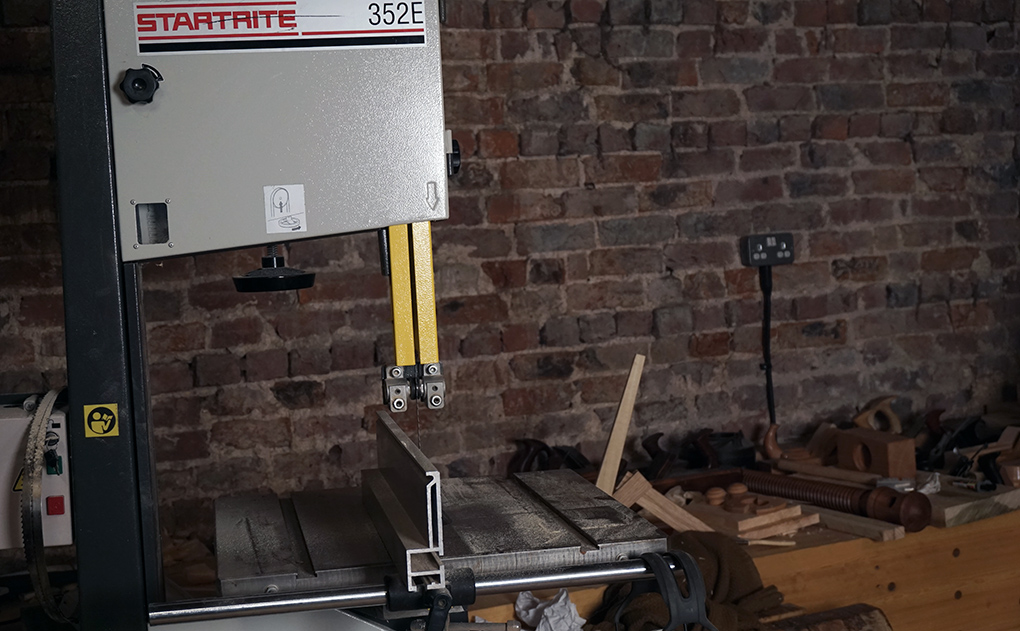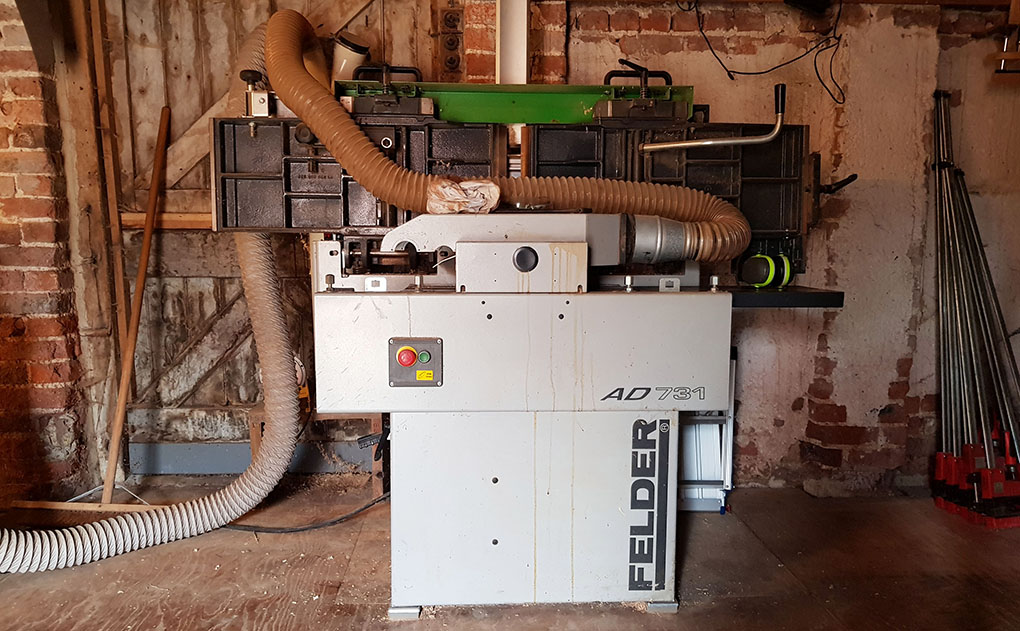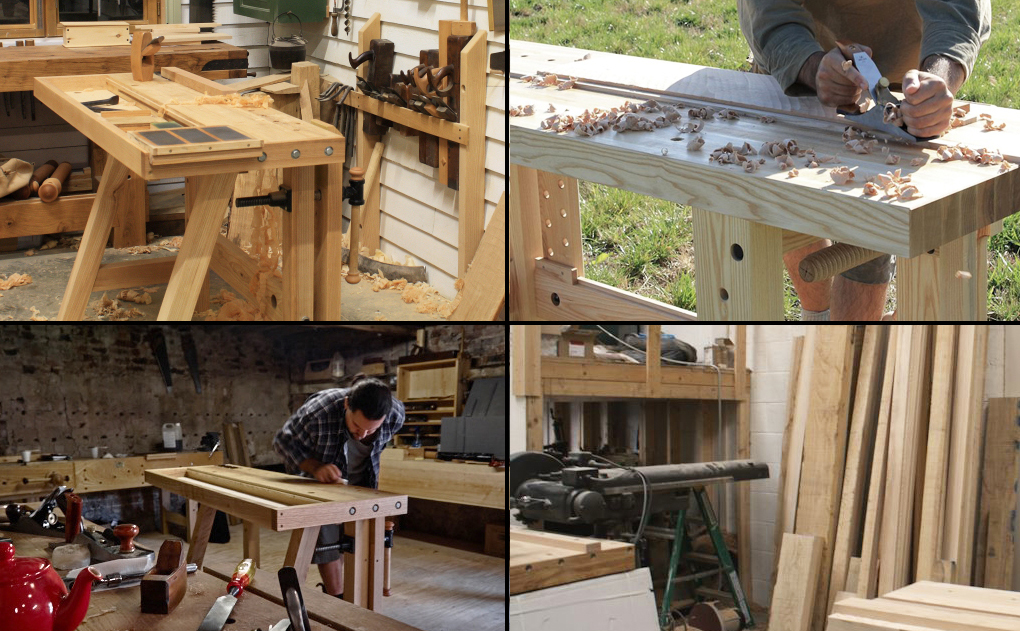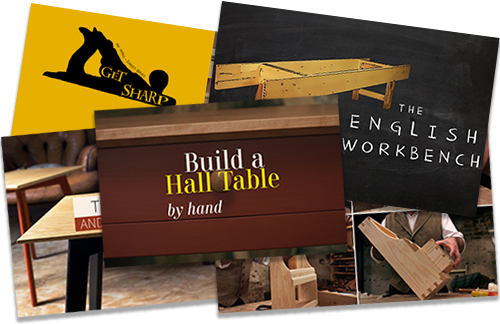No, you don’t.
As a hand tool woodworker you are fully self sufficient without a bandsaw. At least as long as there’s tea in the pot.
But if there’s one machine that can aid the hand tooler the most, this would be it.
When I shunted out my machines at the close of the workbench business, it was my bandsaw that got left behind.
What Is A Bandsaw Used For?
Mine is nothing fancy, just a little Startrite 352.
It maxes out with a half inch blade, but as an aid alongside my hand tool woodworking, that’s all I need; A half inch, 3 tpi, thin kerf blade for ripping.
And that’s all I use it for – ripping.
The bandsaw, it’s the machine that’s most like man.
It’s stood up right for one, so takes up little space. It’s underpowered, which is good, it makes you question whether it’s really the best option for that little rip in the one inch stuff. It whines, moans and groans when in use… comforting. It’s also quite rough and inaccurate.
So the bandsaw doesn’t seem that much better than a hand saw. And that’s right it isn’t, but it’s a hand saw with endurance. It moans from the second it’s started, but it will moan for hours on end, long after you, your hand saw, and the teapot have emptied.
Do I Really Need A Bandsaw?
If you only work with one inch timber, maybe the odd bit of two, then you won’t need a bandsaw; hand saws are very efficient at ripping that thinner stuff.
But if you work a lot of two, three and four inch, then you’ll know what a job it can be. That’s where the bandsaw comes in, it will blank out all the parts for a table, from thick waney edged oak, before your dinner break, and you’ll still have the strength to pour your tea.
But I like it most for the little it takes away from my work. The marks it leaves are that of my hand saws, or even the saw mill. This means the follow up processes are the same as without it, so this machine doesn’t change the approach I take to my work.
This is different to a machine such as the planer, which regulates my work in a inhumanly way, changing the processes that follow – face and edge marks become irrelevant, everything is flat, square…uniform.
I’ll rant on about regulated woodworking soon, but I think you get the point.
The bandsaw is a labour saver for when things get tough, nothing more, nothing less. It’s my second man, my apprentice.
Though handsaws can’t come close to the bandsaw for speed, I’ve been shocked at well a good framesaw can tear through timber. If you’re looking for a bandsaw alternative, definitely consider a framesaw.
And if you’re setting up without any machines at all, have a check through our guide to The Complete (yet minimal) Hand Tool Kit For Woodworking



![Simple Work Holding For Ploughing Grooves [Without a Tail Vice]](https://www.theenglishwoodworker.com/wp-content/uploads/2022/07/workholding-without-tail-vice-copy.jpg)



The bandsaw is definitely the last machine I would part from.
I like it for rough sculpting too.
Mine doesn’t moan, it howls. Spooky.
I am fortunate to have a reliable bandsaw, so much so that I have considered ridding myself of the tablesaw. It’s those times when you need to rip 15 or 20 things to exact size that have convinced me to keep it around (for now). I fear the thing will steal one of my fingers some day, a concern I don’t have with the bandsaw (yes, i’m still careful with it).
Hi Jeff, I could count the hours on one hand for the experience I have with a table saw, but I do remember it frightening the life out of me!
I have a band saw much like yours. Except mine also burns the wood. Kind of like that cousin nobody speaks about.
Possible causes:
1. Feed Rate too high for the particular cut – esp resawing thick stock
2. Blunt blade
3. Too many teeth per inch for the particular cut – again esp thick stock
When resawing thick stock, if the gullet overfills with trapped saw dust, the heat generated can be enough to set fire to it and your shop! Changing to a blade with a large gullet (fewer TPI) will help maintain a higher feed rate without burning the stock. Too high a feed rate will also exacerbate bandsaw drift. Hope this helps.
Thanks Gordon, that’s remarkably helpful.
Skip tooth blades.
But then I wonder: what is the most efficient way to rip purely by using hand tools? I assume those tools also evolved over the centuries (and continents) to become as efficient as they can get. What would be your recommendations there?
Cheers,
Özgür (Oscar)
Hi Oscar, for the very heavy stuff it kind of comes at the cost of a second man. Frame saws are what I’ve concluded so far to be the most efficient method though, but I do feel that hand saws just get rather inefficient with thicker stuff.
I’m still experimenting to find this answer, but I will get to you. Sound like a good series.
It also cuts on the down stroke which makes it the safest of power saws. No peripheral speed of 2 light years which can throw wood back at you to worry about either. Set up properly with a good blade it can cut fine veneer and nothing compares for cutting curves in 3 – 9 inch timber. Can you tell I am a bandsaw fan?
Nope, not at all 🙂
Perhaps Ozgur has heard of a “Pit Saw” a two man “cross cut” type rip saw used for ripping out boards from large stock? Or the “Bow Saw” with a “ripping blade”. Both saws work well, but turn woodworking into a “work out” There is also the standard one handle “rip” saw, slow but sure.
A band saw on the other hand , removes some of the “grunt” work, it is also (mostly), easy on the ears . In my opinion a good compromise for those of us that don’t have unlimited time to practice our avocation.
Thanks Steve, very well said.
When I rip I normally stay a shy of a 16th but if I start to muck up that’s only time I ‘ll fire up my bandsaw, I also use it for resawing. Many people talk about drift and in all my years I’ve never experienced this unless my blade was blunt. Call my fortunate and probably am but I think a properly setup bandsaw with the right blade will not drift.
Hi Salko, I agree, I’ve never experienced the issue of drift. I think a lot of folk put too big of a blade in them which can mean the bandsaw can’t handle it.
I recently experienced drift with two blades. The first was caused by pitch buildup on the inside of the blade, from resawing southern yellow pine. I cleaned the blade and now it tracks straight. The second was caused by a defective blade. Calipers showed the teeth were only set to one side.
Richard
Whilst you can rip everything by hand it sure helps to have a bandsaw for the larger lumps of timber. A sharp blade is of course essential but they are relatively cheap to replace. You can tell by the sound when it is time to change the blade and on occasions the slight burn marks you get with a blunt saw. So as you say not essential but by god does it help.
Len
Nothing wrong with the Startright. I had one when they were first on the market and they impressed then as they do now. The rubbish machine I share now is awful and despite changing to roller guides it drifts all the time. This is made worse when people force wood through it. Perhaps I can get hold of a second hand Startright!
Yep, I have to admit it’s never let me down. I’d certainly recommend them.
I’ve had two table saws and sold both of them as they’re too inaccurate and take up far too much space. I now have two bandsaws; a big Strartrite for big stuff and a new Axminster Trade BS11 for little stuff. Whatever bandsaw you use, it’s only as good as the blade you’ve got fitted. If you have a track saw and MFT for sheet stuff, you don’t need a table saw either.
A bandsaw with a Tuff Saws blade is the only machine the hand tool worker needs.
I have to agree, the Tuff Saw blades are very, very good.
I’ve used Tuff saw blades for some years and they’re good, but certainly no better than Axminster blades. The DG or ‘diamond ground’ blades are really superb and last for ages.
Rob, in fairness, aren’t you omitting something in this context?
Like you, I am very keen on Axminster for many things. – their customer service is second-to-none for example. Except, arguably, Tuff Saws for bandsaw blades.
I haven’t bought an Axminster bandsaw blade recently, although I ‘inherited’ some unused ones with my bandsaw some years back. They worked OK , but the ones bought from Tuff Saws were transformational.
@Richard M.:
Bandsaws are weird beasts, mainly because there is so much odd geometry involved, and to get a really good setup you have to take it into account. The box-frame steel ones are different to the cast frames, as they bend differently under tension, and each model seems to have its own oddities. And it will vary depending on the size of blade you’re fitting and the task in hand.
Mine is a small SIP, and the setup is hugely different between thin blades for twisty stuff, and chunky resaw ones. If I ignore that, the results are disappointing (whichever blade is fitted). If I take the extra few minutes, the results can be superb.
Horses for courses. Hand tool work is fun, but resawing for hours at a time by hand simply isn’t.
Honestly. If you doubt me, I have some oak I need for a current project, and you’re welcome to come over and prove me wrong. I’ll gladly watch and learn about big rip saws, and even supply tea… After you’ve had enough, I’ll plug in the bandsaw 🙂
The only machines I have left are a bandsaw and a lathe. The lathe mostly sits there without much to do, but I love turning when the opportunity presents. The bandsaw gets used for ripping and resawing. I have a 1/2″ blade or two, but it’s a 3/4″ that is on the saw most of the time.
Any machine only works as well as the operator is capable of doing good setup. I can do accurate work with about any machine, but since leaving behind the world of sheet goods–and retiring–I’m glad to be shut of the noise and dust.
A bandsaw is a pretty good dust maker, I couldn’t enjoy woodworking if every operation created as much dust!
As someone who is just getting started in woodworking, coming from a carpentry background, the message I take away is you want a band saw that wheezes a bit less than you. And only for those times when you wheeze too much!
Bang on!
i’d love a bandsaw, but for now a well sharpen disston rip ,
I completely agree Richard. I’d add that, aside from saving time with rips that could be done by hand, the bandsaw does three good things. One, it cuts logs. I use a Hammer 4400 – a little bit more 12 inch capacity and will slice logs with a bigger diameter if flanking cuts are made first – logs have to be supported so they can’t roll and jamb the saw and the weight has to be taken on an independent frame and not the bandsaw table. Good to have someone else around too when you tackle sizable logs. Two, it easily cuts wide, thin veneers less than one sixteenth to one eighth inch. That liberates the way I can build things and use the grain. Three, it lets me explore thick planks with angled resaw cuts – really important to get the best from the grain. Of course, all three are possible in principle using only hand saws, but the real point is that most of us would/might only do any of these things by hand very rarely, whereas it becomes second nature to think about doing them with the bandsaw. A good solid resaw fence and a sliding cradle for logs and thick boards are all that’s needed and easily knocked up. Another thing I like about the bandsaw is that you can feel you are feeding it by hand, in this respect it’s almost like a hand tool that’s motor-driven.
I used to cuss at my bandsaw because it would wander on resawing cuts. Then I bought a “Wood-slicer” blade and suddenly with no additional adjustments or jigs it cuts true, straight and smooth. I was so happy that I got the bandsaw a present, I bought a nice dovetail saw and it seems to be okay with me using it.
Had a fold up saw table(site saw) but kept it unfolded so it magnetically accumulated all sorts of stuff on it’s surface. Boxes of screws, tools, bits of wood, etc and i had to clear it everytime to use it. I was conscious everytime i used it not to go back in the house less a finger. Sold it in the end. Got a Record bandsaw and now much happier. Does all i need and more, compared with the table saw and i’m more likely to keep my fingers. Also the table saw has this noisy high speed whine whereas the bandsaw is a low speed hum. Nice.
Indeed. If you examine many of those apparently ‘unplugged’ workshops on YouTube videos, you will see a band-saw lurking just in shot somewhere. I haven’t got one, but that’s simply because I have only a tiny space to build in, and I’m not in any sort of hurry. I would get one if I had the space for it, but meanwhile I get a decent ‘work out’ from ripping stock now and then, and always feel a touch of pride when I look at those two thin boards I’ve made. ALL woodworking is some sort of compromise between the industrial and the hand-only approach, unless you mine your own iron ore to begin making your chisels, and fell the tree from which you make the handle. Where yo pitch that compromise is entirely up to the individual, and there are really no right and wrongs, as far as I can see.
I have two. I got one as a trade against a combi machine and it’s good for cutting parts that I can’t be bothered to faff about with. The other was a bucket list item. It’s an old Makita resaw machine. It’s sole purpose in life is to rip and with a 3inch blade in it, it does a cracking job of it.
I keep some machinery around in an enclosed area of the basement workshop just for prepping or roughing things out. I favour the older Japanese made machines so when I find one, I buy it. Otherwise it’s all Japanese hand tools with the exception of a veritas router plane and record 044.
I’m kind of in the middle, I use a bow saw I made following Paul Sellers’s video using a snapped section of 1/2 inch bandsaw blade. When I made it I took the time to measure my stroke so I could get a longer cut. As I’m 6ft4 I ended up with a 700mm blade length which makes for a long steady cut. Also I use it on long rips in a “French style”, two wide saw horses with my fat arse sat on one bit sawing towards the family jewels. Obviously you need to pay attention and shuffle the board along before you take your knackers off but it beats standing over a saw horse.
Good article with good reminders. The most important item I found was the blade and guide adjustment note. I ruined a new one-inch blade by allowing the teeth to come in contact with the wheel guides.
I must admit I filled my shed with a table saw, mitre saw and thicknesser plane, the table saw is hardly used, my mitre saw is used only on my construction projects the planer is used for roughing the timber which is my used power tool. A band saw is one power tool I will be buying as it will be useful as in the article for ripping my timber and since my shed is 10×8 feet space is a premium it will be a small Record one. The table saw is noisy and dangerous and wish I had found the English Woodworker together with Paul Sellers and Tom Fidgen when I was setting my workshop up as my choices would have been different. Many thanks for some excellent advice.
Unlike a table saw, a band saw is much more forgiving when cutting rough sawn lumber in that if the piece is not perfectly flat, it can’t move/tilt/bounce as it may in a table saw and cause a kickback. I very much appreciate this extra safety it confers. But while I do regularly use it for rips, I find it indispensable for resawing. My sawing technique leaves much to be desired and for the life of me I can never seem to cleanly resaw timber by hand. Richard, I’m curious as to how you go about the process or if it’s covered in one of the video series.